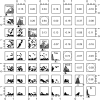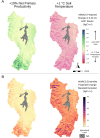Optimizing process-based models to predict current and future soil organic carbon stocks at high-resolution
- PMID: 35752734
- PMCID: PMC9233666
- DOI: 10.1038/s41598-022-14224-8
Optimizing process-based models to predict current and future soil organic carbon stocks at high-resolution
Abstract
From hillslope to small catchment scales (< 50 km2), soil carbon management and mitigation policies rely on estimates and projections of soil organic carbon (SOC) stocks. Here we apply a process-based modeling approach that parameterizes the MIcrobial-MIneral Carbon Stabilization (MIMICS) model with SOC measurements and remotely sensed environmental data from the Reynolds Creek Experimental Watershed in SW Idaho, USA. Calibrating model parameters reduced error between simulated and observed SOC stocks by 25%, relative to the initial parameter estimates and better captured local gradients in climate and productivity. The calibrated parameter ensemble was used to produce spatially continuous, high-resolution (10 m2) estimates of stocks and associated uncertainties of litter, microbial biomass, particulate, and protected SOC pools across the complex landscape. Subsequent projections of SOC response to idealized environmental disturbances illustrate the spatial complexity of potential SOC vulnerabilities across the watershed. Parametric uncertainty generated physicochemically protected soil C stocks that varied by a mean factor of 4.4 × across individual locations in the watershed and a - 14.9 to + 20.4% range in potential SOC stock response to idealized disturbances, illustrating the need for additional measurements of soil carbon fractions and their turnover time to improve confidence in the MIMICS simulations of SOC dynamics.
© 2022. The Author(s).
Conflict of interest statement
The authors declare no competing interests.
Figures







References
-
- Janzen HH. Carbon cycling in earth systems - A soil science perspective. Agric. Ecosyst. Environ. 2004;104:399–417. doi: 10.1016/j.agee.2004.01.040. - DOI

